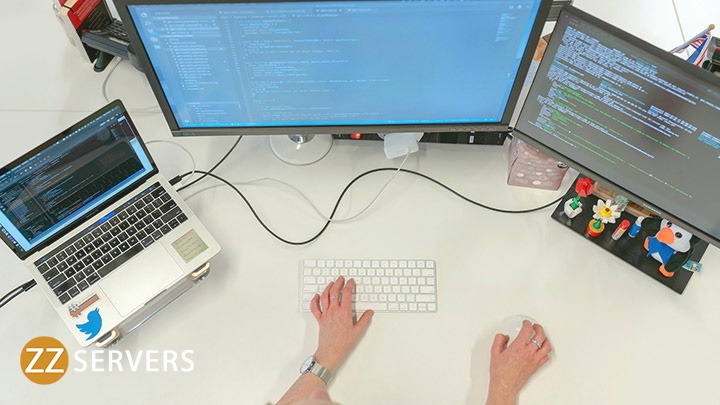To answer the question “What are examples of SaaS?” let us explain that SaaS stands for Software as a Service. SaaS provides computer programs over the internet rather than through downloads or installations. It means users can access the Software from anywhere, on any device, without upfront costs for servers or licenses.
Some key benefits of SaaS include:
● Low upfront costs with affordable monthly/annual subscriptions
● The provider manages automatic software updates and bug fixes
● Scalability that allows adding more users or storage as needs grow
● Easy collaboration using multi-user access and real-time information
● Increased productivity through streamlined workflows and mobile access
This article will explore popular SaaS categories like CRM software, project management tools, communication platforms, etc. It will also feature in-depth reviews of top SaaS providers such as Salesforce, ClickUp, and Zoom to help you determine the right solutions for your business needs.
The Rising Tide of SaaS Adoption
The SaaS industry has experienced tremendous growth in recent years and shows no signs of slowing. According to analysts, the global SaaS market is projected to be worth over $150 billion by 2025. Here are some key trends fueling this explosive expansion:
● Embrace of Cloud Computing: As cloud infrastructure and security mature, more businesses recognize the strategic and financial benefits of the cloud model. SaaS perfectly complements this shift by delivering applications through the same flexible, on-demand approach.

● Mobile and Remote Work Revolution: The pandemic accelerated our transition to remote and hybrid work environments. SaaS solutions have never been more critical for powering collaboration, project management, sales, and more from any location.
● Rise of Startups: Thanks to cloud platforms and online marketplaces, it’s easier than ever for entrepreneurs to launch innovative SaaS products. This startup boom continuously introduces new solutions.
● Emphasis on Customer Experience: Companies now compete based on CX more than ever. SaaS tools streamline customer management, marketing, and service workflows to improve every touchpoint.
● Demand for Specialized Solutions: As industries mature, there is a growing demand for specialized applications tailored for specific verticals like healthcare, education, finance, and more.
● Prioritizing Operational Efficiency: Businesses seek to maximize productivity and optimize processes. SaaS automates manual tasks, shares real-time insights, and suggests improvements to work smarter.
All signs point to continued expansion of the SaaS sector as these trends maintain momentum. Modern enterprises cannot compete or adapt quickly without the agility and capabilities provided by cloud-based applications.
Common Software Types to Consider
With many SaaS applications available, choosing where to begin can feel overwhelming. Let’s break down the main categories to help narrow your search.
● Project Management: These tools help teams organize work, assign tasks, track progress, and collaborate on projects. Popular options include Asana, Trello, and Monday.com.
● Customer Relationship Management (CRM): CRMs centralize customer profiles, sales pipelines, marketing campaigns, and support workflows. Salesforce and Hubspot lead this category.
● Communication & Collaboration: Slack, Teams, and Zoom enable messaging, file sharing, and video meetings to unite geographically dispersed teams.
● Creative & Design Software: From graphic design to video editing, these SaaS suites empower creative professionals. Leaders are Adobe Creative Cloud, Figma, and Sketch.
● Accounting & Finance: Solutions like QuickBooks, Xero, and Wave simplify billing, bookkeeping, expense tracking, and financial reporting.
● Content Management: Platforms such as WordPress and Drupal provide websites, e-commerce, and marketing content capabilities.
● HR Management: Software like BambooHR, Gusto, and Namely handle payroll, benefits administration, recruiting, and other HR functions.
There are also specialized SaaS tools for industries including healthcare, education, real estate, and more. Consider your teams’ core tasks to identify one or two categories requiring the most support. From there, research specific solutions.

CRM Leader: Why Salesforce is a Top Choice
When exploring CRM software, it’s necessary to recognize industry pioneer Salesforce. This customer data powerhouse is trusted by over 150,000 organizations globally.
● Unmatched Functionality: Salesforce offers a complete platform to manage leads, contacts, accounts, and more. Intuitive modules handle marketing, sales, service, and commerce across all channels.
● Automated Workflows: Pre-built process automation streamlines tasks like lead scoring, opportunity stage progression, and forecasting. Custom flows can also be created.
● Omnichannel Engagement: Gain a 360-degree customer view across digital touchpoints like web, mobile, social, chat, and call centers. Nurture prospects through personalized journeys.
● Actionable Insights: Real-time dashboards deliver vital metrics to track pipeline progress, spot opportunities, and fine-tune strategies. Robust reporting and analytics explore trends.
● Ecosystem of Apps: Over 4,000 pre-built apps integrate with Salesforce to extend capabilities. Options include Pardot for marketing, Tableau for visualization, and Quip for team collaboration.
● Superior Support: The vendor prides itself on implementing best practices, admin training programs, and 24/7 support. Consultants are available to optimize deployments.
It’s clear why over 150,000 companies rely on Salesforce to power their sales processes. The platform’s breadth, automation, insights, and ecosystem make it a safe, long-term choice for startups and enterprises. Its market dominance is well-deserved.
Project Management Powerhouse: Features of ClickUp
ClickUp has quickly risen to the ranks as a leading project management solution. With an intuitive interface and extensive capabilities, it’s easy to understand why.
● Customizable Workspaces: Create boards, lists, and cards to map out workflows visually using Kanban, Gantt, calendar, and list views. Customize over 50 fields to your needs.
● Powerful Automation: Pre-built bots simplify repetitive tasks like assigning, commenting, and notifying. Code-free workflows integrate apps and trigger actions.
● Comprehensive Tasks: Each task supports checklists, attachments, comments, due dates, and more—link-related items like files, conversations, and other charges.
● Robust Reporting: Dashboards, pivot tables, and customizable reports deliver real-time progress tracking across teams and projects.
● Flexible Access: The web and mobile apps ensure teams can collaborate from anywhere. Integrations with Slack, Gmail, and 150+ apps enhance flexibility.
● Feature-Rich Editor: Format documents, spreadsheets, and slide decks directly within ClickUp without switching apps. Version control is built-in.
● Strong Security: Robust permissions, two-factor authentication, and encryption protect sensitive organization and customer information.
Over 200,000 companies use ClickUp to streamline project execution from start to finish. Its adaptability, automation capabilities, and unified workspace make complex initiatives appear simple – a testament to its powerhouse status in modern project management.
Video Conferencing Giant: How Zoom Became so Popular
The COVID-19 crisis drove unprecedented reliance on video communication tools. No platform benefited more from this seismic shift than Zoom. Let’s examine how it grew into a collaboration giant.
● Seamless User Experience: Zoom’s simple, intuitive interface made joining meetings effortless for tech-savvy professionals and first-time users. This low barrier to entry fueled adoption.
● Reliable Functionality: While usage skyrocketed, Zoom delivered clear call quality and reliability even on low-bandwidth connections. Few outages maintained user trust.
● Cross-Platform Access: The Software runs natively on Windows, Mac, iOS, and Android, as well as via web browsers. This ubiquity allowed participation from any device.
● Engaging Meeting Features: Options like screen sharing, virtual backgrounds, polling, breakout rooms, and non-verbal feedback fostered interactivity beyond audio calls.
● Robust Security Updates: Continuous improvements secured the platform in response to scrutiny. Features like waiting rooms, passwords, and encryption now better protect meetings.
● Affordable Pricing: Even the free Basic tier accommodated most personal and some business needs, while Plus and enterprise plans scaled with demand.
● Superior Support: Zoom provided 24/7 assistance navigating the surge through training, webinars, and a vibrant online community of users helping each other.
By empowering connection through such challenging times, Zoom earned its place as not just the video app people use – but the one they continue using even as work models evolve.
Take Your SaaS Strategy to the Next Level
You now have a solid understanding of the most popular SaaS categories and leading solutions available. The experts at ZZ Servers can help evaluate your specific business needs, shortlist compatible options based on budget and long-term goals, implement seamless integrations, provide end-user training, and ensure you maximize your ROI on these powerful cloud-based applications. With over 17 years of experience deploying and managing SaaS tools for small-to-mid-sized enterprises, our certified professionals deliver predictable, measurable results backed by 24/7 support. Contact us today at 800-796-3574 to discuss how we can help your organization take the next step in its digital transformation journey.
Conclusion
In summary, this article aimed to answer the question “What are examples of SaaS?” by:
Exploring the top SaaS categories such as CRM, project management, communication, and creative tools that many businesses leverage
Providing in-depth reviews of leading SaaS providers like Salesforce, ClickUp, and Zoom to understand their fundamental capabilities and how they help transform operations
Analyzing current trends in the expanding SaaS market, including growing demand for specialized vertical solutions and prioritizing seamless collaboration
Highlighting essential factors to consider when evaluating and selecting SaaS, like organizational needs, budget, functionality, security, and support
Frequently Asked Questions
u003cstrongu003eWhat are the key benefits of using SaaS?u003c/strongu003e
The main benefits of SaaS include lower upfront costs through flexible subscription models, automatic updates managed by the provider, and scalability to support distributed teams. SaaS also simplifies collaboration through unified data access, streamlines workflows for increased productivity, and reduces IT burden through a low-maintenance cloud-hosted environment.
u003cstrongu003eHow much does SaaS typically cost?u003c/strongu003e
SaaS pricing varies depending on features, storage, users, and customization needs. However, most providers offer free trials and affordable monthly plans starting at $5-10 per person to cater to all budgets. You can also opt for pay-as-you-go models, allowing predictable costs that scale with your business.
u003cstrongu003eHow do I choose the right SaaS for my business?u003c/strongu003e
When selecting SaaS, consider your specific pain points and core workflows. Evaluate solutions catering to your industry and team size. Demo popular options to compare integrations, ease-of-use, and value adds. Lastly, assess training support security certifications and review success stories from similar organizations.
u003cstrongu003eWhat are some free SaaS tools to try?u003c/strongu003e
Some excellent free SaaS tools include Google Workspace, Dropbox, Zapier, and Trello. These provide essential collaboration, file storage, automation, and project management features. You can then upgrade subscriptions as demands increase over time.
u003cstrongu003eHow do I switch between SaaS providers?u003c/strongu003e
Migrating between providers involves planning for data migration, testing new integrations, and training users on any process changes. Most SaaS offer migration tools and services. It’s best to start with a pilot group, gather feedback, and ensure a smooth transition. Opt for vendors with simple onboarding programs.



